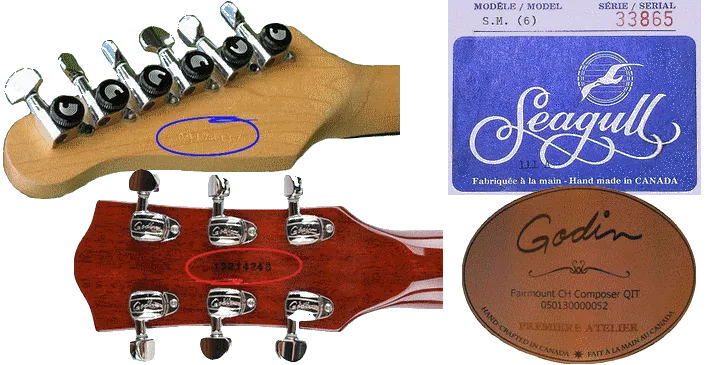
The serial number systems for Godin guitars can sometimes be a bit complex but can usually be traced back to a date.
Table of Contents
Godin Serial Number Location
The serial number is stamped on the back of the headstock, and on acoustic models, it can be found on the label inside the soundbox.

4 and 5-digit Godin Serial Number
The four-digit numbers were used from 1982 to 1986.
Five digits from 1986 to 1993.
For dating 6-digit serial numbers, it is best to contact Godin.
7 and 8-digit Godin Serial Number
Dating the 7 and 8-digit serial numbers is somewhat complicated. Godin started using seven-digit numbers in early 1993 and eight digits in 1995.
The method for a seven-digit number is the same as for an eight-digit one.
Godin uses a fiscal year for dating, which begins on August 1st.
Example: 02062032.
The first two digits 02 indicate the year.
The next two digits 06 represent the week. This is the week number in Godin’s fiscal year, counted from August 1st. In this example, it is six weeks after August 1st, 2001, corresponding to September.
The third digit 2 indicates the day of the week (Tuesday), and the last 3 digits represent the serial number.
The manufacturing year of the serial number 02062032 is Tuesday, September 4, 2001.
12-digit Godin Serial Number
In late 2007, Godin switched to a twelve-digit serial number. There is no dating information in this serial number system.
The first 6 digits represent the model code.
The 7th digit is a factory code (factory second) indicating whether there is damage or not (0 = no damage, 9 = damage).
Damage does not mean that the guitar is defective, but rather a minor blemish on the finish.
The last 5 digits represent the serial number of the model.
Example: 050406000540
050406 indicates that the model is ‘Radium Matte Green’. The 0 indicates that there is no finishing flaw.
In this example of serial number 050406000540, it is the 540th Radium Matte Green guitar, without any damage.
Godin History
Robert Godin is a Canadian guitar builder who started his company in 1970 in La Patrie, Quebec. At the age of 7, Robert Godin, born in Montreal, began learning to play the guitar and quickly became fascinated with the instrument. By the time he was 15, he started working at a guitar repair shop in his neighborhood, where he learned the craft of guitar building.
A few years later, he, along with his aunt, took over a small music shop (owned by another aunt), which became one of Montreal’s most successful in the 1960s.
By the age of 20, Godin was already a successful businessman. In 1970, during a hunting trip in La Patrie (a district in Montreal), he met Norman Boucher, a guitarist who had a small woodworking company where he built guitars under the name Norman. Boucher’s business was struggling, and he had plans to sell it. Robert was very interested and decided to sell his share of the music shop and purchase Norman’s company.
Boucher continued to work in the company and led the production, while Godin served as both a designer and a salesman. The La Patrie-based business thrived, and Godin wanted to expand it further. However, Boucher didn’t agree with the expansion plans, leading to Godin’s departure in 1978 to start his own guitar factory in La Patrie (LaSiDo).
Initially, Godin began making components for electric guitars for American companies, but when some of his clients went bankrupt in the late 1970s, LaSiDo almost went under. He stopped the supply activities and reorganized the company in 1980 to focus on guitar building.
One significant advantage of the La Patrie location was its proximity to a wealth of wood (cherry, cedar, and walnut) used for soundboards and necks to build quality guitars.
Without Godin, Boucher’s company went bankrupt, and in 1982, LaSiDo acquired the Norman brand. In the same year, Godin acquired the Seagull trademark and LaSiDo launched the Seagull line.
The goal behind the Seagull guitar was to incorporate handmade guitar features such as solid tops and quality finish into an affordable guitar.
- Following the success of the Norman and Seagull guitars, other lines were introduced.
- The Art & Lutherie line offered key features of more expensive guitars but at an affordable price for beginner guitarists.
- The Simon & Patrick Luthier line combined traditional acoustic guitar design with modern innovations.
- The La Patrie series was designed to present a line of classical guitars.
- The Godin line of electric guitars stemmed from LaSiDo’s original outsourcing activities.
Although the necks and bodies are produced in La Patrie, the guitars are assembled in Berlin, New Hampshire, USA, which was the third factory opened by Godin in 1993.
In 1995, a fourth factory was opened in Princeville, Quebec, and in 2002, a fifth in Richmond, Quebec.
In the latter half of the 1990s, LaSiDo became a leading North American guitar company.
Influential popular musicians like Billy Corgan of the Smashing Pumpkins and Metallica’s Kirk Hammett played Godin guitars, which brought publicity.
Business was so good that in 2001, the company expanded its primary factory in La Patrie, adding around 25,000 square meters for storage and a separate production line for high-quality acoustic guitars.
Godin Guitars now has 6 factories. Responsible for exports are Robert Godin’s sons, Simon and Patrick.
Since 2019, the company has been led by Simon Godin.
My introduction to Godin guitars was completely accidental, but I was genuinely impressed by their design and quality. I remember browsing their website on a small shop’s page in my city and decided to visit them in person. It seems like there are so many guitars out there, and you might think it’s all about how they sound. But then you pick up a Godin and realize there’s something uniquely special about it. It’s a truly heartwarming experience, filled with style and beauty. If you get the chance, definitely try playing one!

